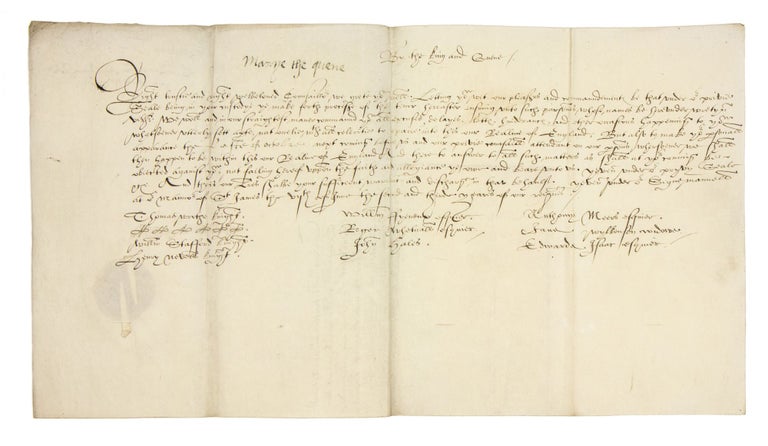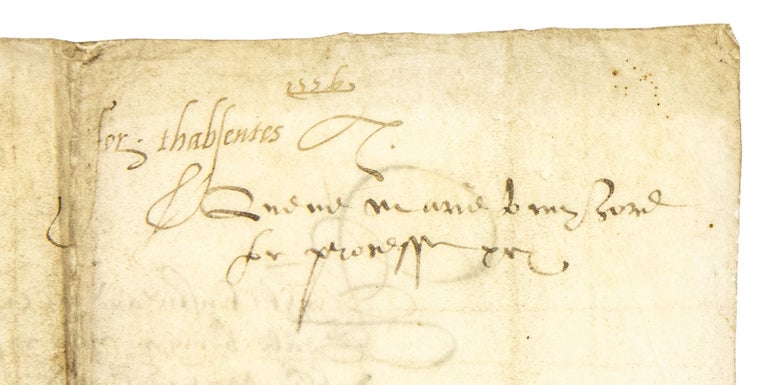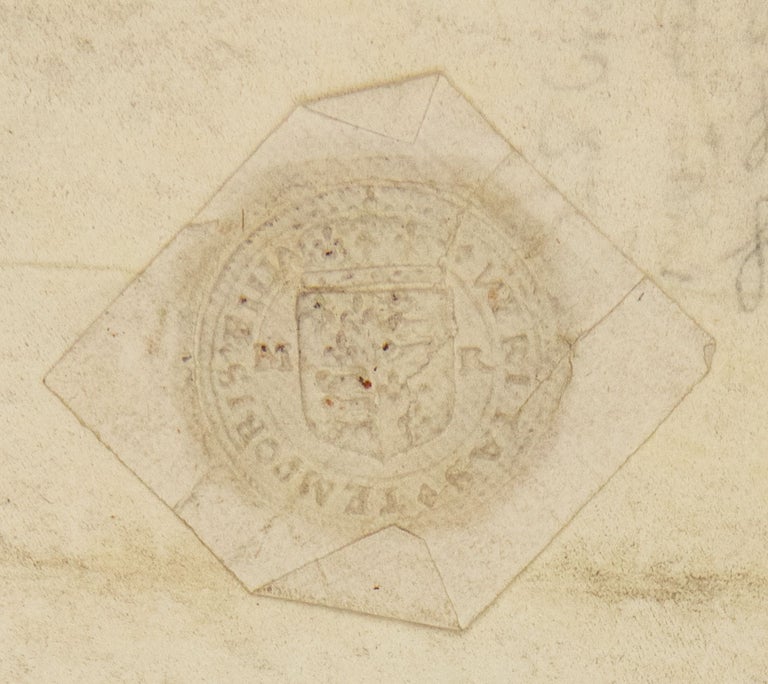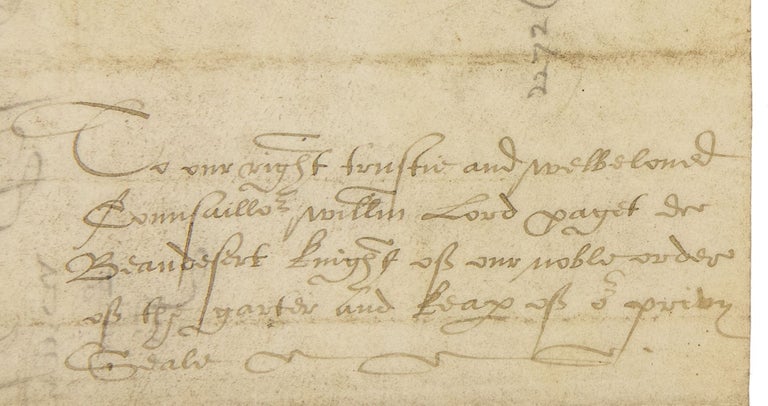Letter on vellum signed "Marye the Quene" to Lord Paget, signed at head, titled at head "By the King and Quene".
London: St. James's Palace, 7th June, 1556.
Price: $50,000.00
Vellum: 194 x 345 mm.
Blind-stamped paper seal and address panel on verso "To our right trustie wellbeloved Counsillor Lord Paget de Beaudesert...", docketed on verso: "for thabsentes... Quene marie to my Lorde for process xvi"
A remarkable letter, signed by Mary Tudor as Queen, instructing Lord Paget as Keeper of the Privy Seal to send messages to ten Tudor exiles: Sir Thomas Wroth, an unidentified individual whose name has been obliterated, Sir William Stafford, Sir Henry Neville, William Fiennes "Fyenenes", Roger Whetnall, John Hales, Anthony Meres, Jane Wilkinson, and Edward Isaac. The exiles are to commanded to return "wth all celeritie to repaire into this our Realme of England; But also to make “yor p[er]sonall apparance the laste of October next coming before us and our privie counsaill attendant on our p[er]sone... And then to answer to all such matters as shall at yor coming... nat failing hereof uppon the faith and allegiance ye owe and beare unto us".
By June 1556 Mary’s regime had condemned to the stake more than 100 religious heretics, including one of the most high-profile offenders, Thomas Cranmer, in March of that year. While religious heresy was of prime concern to the queen and her government, the problem of seditious activities of the English exile communities in Europe, especially the community at Frankfurt, also required serious attention. Another important motivation for bringing the exiles home was to reclaim for the Crown lands owned by the exiles, especially former monastic lands dispersed under Henry VIII.
“It was in the summer of 1556 that the Marian government first took steps to deal directly with the Englishmen gone over-seas. Efforts to reach them through parliament had failed. Extradition was still a matter of polite agreement between two governments, and uncertain in its operation. If a man was wanted quickly the surest method was to kidnap him. [In June] an attempt was made to improve upon this drastic method of procedure by issuing a commission for the delivery of 'certeyne letters and commaundementes under their Maiestyes pryvy seale’ to those subjects who were residing in Germany without permission.”(Garrett, p. 36)
John Brett was tasked with traveling to Germany to serve these summonses. In the end, Brett, who met with obstruction and threats of violence during his mission, succeeded in meeting with only four of the exiles on his list; none of those contacted obeyed the queen’s order to return to England. Brett wrote a report of his mission, which he delivered to the Council on 18 October (Royal Hist. Soc. Trans., n.s. xt, 120). That narrative, “remains one of the most illuminating documents of the Exile.”(Garrett)
“[Eleven] names were posted on Brett's list, though he would unsuccessfully attempt to meet only five -Jane Wilkinson, John Hales, Katherine, the Duchess of Suffolk, and her husband Richard Bertie, and Thomas Wroth. Sir Henry Nevell, William Stafford, William Fyneux, and Roger Whetnall- eluded Brett's attention, not because of oversight but due to the precarious circumstances that ultimately drove Brett off the continent. At least half of the targeted individuals owned extensive property -previous monastic land obtained by purchase or grant in Henry and Edward's reign; but other factors also contributed to their wanted status, which was rendered especially visible and egregious by their prominence as gentlemen. Most had not only held notable positions in Edward's reign, but were enthusiastic evangelicals: Thomas Wroth, according to Strype, was a gentleman of the privy chamber and as such was in "greatest favor" with the king, who "knighted him, [and] heaped great wealth, honours, offices, and possessions upon him." Henry Nevell also belonged to Edward's privy chamber, while William Stafford was a member of the Privy Council and Edward Isaac a figure of wealth who associated with his friend Hugh Latimer from early on…
“While the [eleven] individuals on Brett's list were dispersed across Europe, they nevertheless belonged to a larger exilic community that allowed it to close ranks against the intruder and to transmit warnings and other information along a well-coordinated underground network that extended across regional and national border… many of the exiles encountered by Brett seem to have been expecting him, and few greeted him alone; all came to the encounter prepared with a strategy, variously confronting Brett with avoidance, threats, legalisms, and if all else failed, violence. Indeed, while Ponet, Goodman, and Knox were explicating their resistance theories in pamphlet or treatise form, contemporaries such as John Hales or Jane Wilkinson were enacting disobedience on the ground, according to more improvisational, if not less effective, means.”(Covington, p. 419)
The exiles named in this document:
(1). Sir Thomas Wroth (1518?-73), courtier and landowner, one of the four principal gentleman of the chamber, two of whom were to be at all times in personal attendance of Edward VI and were present when he died. According to Strype, he was in "greatest favor" with the king, who "knighted him, [and] heaped great wealth, honours, offices, and possessions up him.” He proclaimed Lady Jane Grey as queen but also joined in proclaiming Princess Mary as queen once her accession became inevitable. Wroth was sent to the Tower late in July 1553; he was included in the general pardon; charged with complicity in the rising of Henry Grey, Duke of Suffolk, he fled overseas. Wroth, Brett’s “primary target in Strasbourg…was elusive and would never in fact be tracked down.”(Covington)
(1a.) Obliterated. Possibly Katherine, the Duchess of Suffolk, or her husband Richard Bertie, both of whom appeared on Brett’s list.
(2). Sir William Stafford (c. 1500-56), courtier, second husband of Mary Boleyn (d. 1543), sister of Anne Boleyn (and mistress of Henry VIII). He was a member of Edward VI. ‘Privy Council, In 1554, along with his second wife, children, sister, and cousin, Stafford removed to Geneva, where he died on 5 May 1556, a fact clearly unknown to Mary I at the time that this summons was issued.
(3). Sir Henry Neville (Nevell) (c. 1520-93) was the son of the conspirator Sir Edward Neville, whom Henry VIII had executed in 1539. Remarkably, the king eventually elevated Sir Henry to be a groom of the king’s privy chamber. He was further elevated under Edward VI, who knighted him in 1551. His Protestantism forced him to leave England during Mary’s reign. If he received Mary’s summons, he did not heed it, and returned to England during Elizabeth’s reign, dying in 1593.
(4.) William Fyneux (Fiennes) An obscure figure, "seems to have returned to England and conformed to Mary's religion before his death in 1557.”(Covington)
(5.) Roger Whetnall (Wetnall), perhaps of Besthorp, Norfolk. Another obscure figure. His brothers, Thomas and George, lent their signatures to a letter from the exile congregation at Frankfort to that at Strasburg on December 3, 1554.
(6). John Hales (1516?-1572), a fervent Protestant, zealous for religious and social reform, “was forced to leave England in 1550-51, following the agrarian rebellion and Somerset's fall. Hales traveled extensively during the 1550s, and was exposed to the views of important English and continental reformers. Following Mary Tudor's ascension, the ideology that influenced Hales assumed a more radical tone as reformers fled from persecution and worked toward refining the form of Protestantism they sought to have adopted once Elizabeth ascended the throne. During this period, Hales also worked for William Cecil, indeed he was Cecil's ‘field man in Germany.’ In that capacity, he assisted English ambassadors and reform leaders in the discussions between English and continental reformers concerning the structure of the English Church. This exposure to reformist principles, particularly given the escalation of matters during Mary's reign, left an indelible mark, and Hales returned to England in 1558 a convinced and ardent Calvinist.”(de la Torre)
(7) Anthony Mieres (Meeres, Miers, Meyres). “The second son and heir of Sir John Meeres of Kirton, Lincs. Anthony seems to have come early under Queen Mary's displeasure, for on 18 September 1555 the commissioners who were sent to sequester the lands of Katherine, Duchess Dowager of Suffolk, were instructed 'to do the like towching thee landes, goodes and catalles of one Merys within the same shire;...'. In April 1556 Pole's Visitation of Lincoln marks 'Fuga' before the name of Anthonius Meeres in com. Lincoln. armiger' (Lambeth MSS. Register of Cardinal Pole, f. 17, or Strype, Mem. III, ii, no. 51, p. 390). The record states further that he had fled because he was cited for not receiving the Sacrament at Easter, but his offence must have been a far graver one than that, since nothing short of conspiracy could have warranted the sequestration of his lands and goods. Moreover, he was among those especially named as offenders in Brett's commission of 1556. But before 12 July 1556 Meres had reached safety at Geneva, where he became a member of Knox's congregation. He died in March 1587/8 at the age of seventy-six (Harl. Soc. LI, 664).”(Garrett, p. 286)
(8). Jane Wilkinson (more commonly, Joan) (d. July 1557). The wealthy widow Jane Wilkinson, on-time silkwoman in Anne Boleyn’s court, fled to the Continent only shortly before this summons was issued. She was one of only five exiles on the warrant whom John Brett was successful in meeting on the Continent. “Joan Wilkinson resisted religious conformity under Mary I, but only reluctantly decided to go abroad. Despite the urging of her godly friends, she remained in England after others had left so that she could support imprisoned reformers such as Latimer and Ridley. By remaining, Wilkinson also had access to substantial funds that she used to assist the exile community. By 1556, she resolved to flee and arranged for her family's relocation to Frankfurt. She brought with her an income of several hundred pounds, which she used to sustain other exiles [and three of her fellow widows in exile: Anne Warcup, Elizabeth Brown and Elizabeth Kelke.]. Her generosity even extended to women outside her immediate circle. She left a further sum of £6 to fund the marriages of six poor maidens who belonged to the Frankfurt church, and £100 to be distributed among the English congregations at Frankfurt, Emden, Geneva, and Wesel for the 'sustenance and relief of the poor English congregations' there.”(Harkrider)
(9.) Edward Isaac (Edmond), heavily involved in the exile congregation at Frankfurt, where he antagonized John Knox. Isaac was targeted by Queen Mary for his work in advancing the Reform movement but also in order to reclaim for the Crown the lands that Isaac had accumulated in Suffolk. He evaded Mary’s agent and ultimately returned to England during Elizabeth’s reign.
Brett’s encounter with Jane Wilkinson:
“Brett first made contact in Frankfurt with Jane Wilkinson, a sustainer and close friend of Cranmer, who had urged her early on in Mary's reign to "with- draw yourself from the malice of 'ours and God's enemies, into some place where God is most purely served." Still, her departure abroad had been late, due in part to her choice to stay behind with other wealthy women such as Elizabeth Vane and Anne Warcup, to aid the martyrs in prison for as long as possible. When the situation became too dangerous and the burnings began, it was Warcup with whom Wilkinson fled in the summer of 1556, which dates her arrival very closely to Brett's own. While she did not flee with a royal license-and it is not clear how she specifically fled in the first place-she did manage to escape with the large sum of 6,100 florins, making her the wealthiest of all the exiles in her chosen town of Frankurt. It was here where her monetary support and patronage of others seems to have continued, perhaps above all after her death in 1557, when Edmund Sutton wrote that "she gave to this and other poore congregations of poore banished Englishmen a Christian liberall relief.”
“As a wealthy widow and prominent member of the protestant community at home and abroad, Wilkinson, who had once served in Anne Boleyn's court, would have been appropriate for inclusion on Brett's list for the wealth of land she left behind; by the summer of 1556, however, Wilkinson was ill, and when Brett encountered her-"in the presence of one [Richard] Chambers, John Ade, and William Woode"-she was probably not being wholly disingenuous when she told him that "indisposycion and sekeness" had compelled her flight from England. Her next statement, however-that she "shoulde recover her healthe at the Bathes in those Countreys" but would "repayre towardes England with the best spede she coulde" if the Queen so wished was certainly insincere, and a means by which to free herself from Brett, who was content to leave the designated letters with her and move on to the next target of his visit.”(Covington, p. 420)
Reclaiming lands for the Crown:
“Much of the monastic lands dispersed under Henry fell into the hands, as it happened, of Marian exiles -a fact that made them as important as the heretical religious projects they supported. A sample exploration into Brett's list, for instance, would reveal that Thomas Wroth received grants of abbey lands in Middlesex and Essex and Edward Isaac accumulated vast church lands from Suffolk and other domains, while John Hales -who was even surveyor of lands under Henry -was said to have "accumulated a great estate in monastery and chantry lands”, most notably in Coventry, where he set up a free school in the former St John's Hospital. When Mary came to the throne, a papal dispensation already made official the surrender of such lands, which the queen in turn grudgingly recognized; but the need to permanently regain those lands for the Crown at least for monetary reasons -and not to simply hold them temporarily or in trusteeship, pending a court appearance by the returned exile- was intense, even if she had to adhere to tradition and work through legal mechanisms to do so. In the important and contentious fourth Parliament of 1555, the queen did in fact attempt to rework the law by introducing a bill that would have ordered those who had fled overseas without a royal license to return and face court proceedings, as required, or to forfeit their lands as a consequence. Though the bill passed the Lords, it was defeated in the Commons, due in part to the exertions of Sir Anthony Kingston and William Cecil, with the latter especially upholding the issue of property rights, no matter how much, as Conyers Read once put it, he "[fancied] himself as facing martyrdom for the cause.”(Covington, p. 413).
References: Brett's account of his mission is contained in I. S. Leadam, "A Narrative of the Pursuit of English Refugees in Germany under Queen Mary," Transactions of the Royal Historical Society 11 (1897): 113-31. Covington, “Heretic Hunting beyond the Seas: John Brett and His Encounter with the Marian Exiles”; De la Torre, "We Few of an Infinite Multitude": John Hales, Parliament, and the Gendered Politics of the Early Elizabethan Succession”, Albion: A Quarterly Journal Concerned with British Studies Vol. 33, No. 4 (Winter, 2001), pp. 557-582 (26 pages); Melissa Franklin Harkrider, “Women, Reform, and Community in Early Modern England, Katherine Willoughby, duchess of Suffolk, and Lincolnshire's Godly Aristocracy, 1519-1580”.





